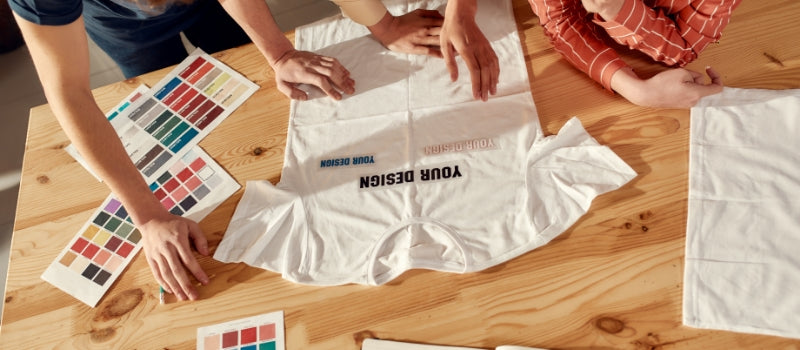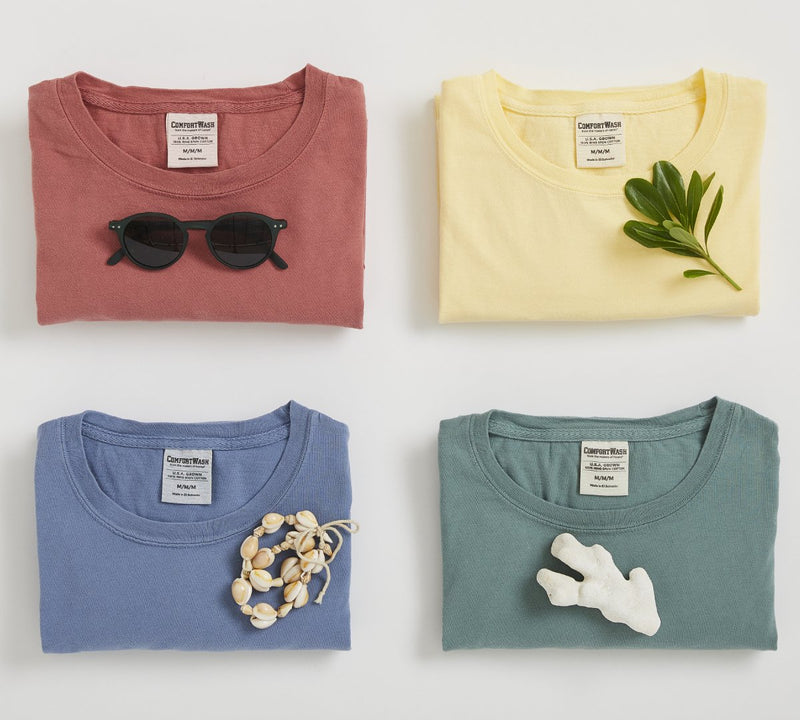If you're looking for a long-lasting, full-color way to decorate your T-shirts, you may have encountered the term' sublimation printing'. What is sublimation printing, you ask? Let's jump right into it.
The sublimation printing process stands out as one of the most effective techniques for printing designs. With sublimation printing, you can transfer any colorful image (including photographs) onto your T-shirts, ensuring that the designs never fade, crack or peel over time. Your graphics will remain as lively as the day they were printed! If this is your first encounter with this process and you're wondering, 'How does sublimation work?', don't worry. Our sublimation guide will cover all you need to know to expertly dye and sublimate your blank T-shirts like a pro, making every piece a masterpiece.
Our Sublimation Guide: The Basics
Let's start with the fundamentals: What is sublimation printing? It is a technique used to print custom designs on various items, especially T-shirts. Also known as dye sublimation, sublimation printing is celebrated for producing high-quality, full-color results. The sublimation printing process involves using a heat source that embeds the ink directly into the fabric, making the design a permanent aspect of the material.
The process begins by printing your design onto special heat transfer paper. Utilizing temperatures between 300 and 400 degrees Fahrenheit and applying pressure, the image is permanently transferred to your shirt, ideally made from 100% polyester or a high-poly-content blend. The ink transitions from a solid state into a gas, integrating seamlessly with the fabric.
Creating Sublimation Transfers
For DIY enthusiasts or small-scale operations, creating sublimation transfers at home or in your shop requires specific equipment. You will need a sublimation printer – a regular office printer won't work as it uses inkjet cartridges designed for paper. A sublimation printer employs special dye sublimation ink that vaporizes under heat.
Comparing Sublimation with Other Printing Methods
Unlike heat transfers and screen printing, where the design sits on top of the fabric, allowing you to feel the print, sublimation printing leaves the fabric smooth to the touch. This method is ideal for designs that require durability and longevity, outperforming other methods in terms of how well it withstands multiple washes without fading, cracking or peeling.
Suitable Materials for Sublimation
What can you sublimate on? Primarily, sublimation is suited for 100% polyester or poly blend fabrics that are white or light colored. Other materials might not hold the design well, leading to faded or washed-out visuals after the first clean.
Sublimation is perfect for custom, smaller order runs, offering the flexibility to include as many colors in your design as you desire without additional setup time. In contrast, screen printing might be more efficient for larger volume orders due to the complexities added with multiple colors.
Sublimation printing is popular because it produces vibrant, long-lasting graphics. However, like every other decorating method, you need to fully understand the process so that you don't do it incorrectly. For example, you might get designs with white creases or "ghosting" patterns if you don't follow the proper steps. If that happens, and you're printing T-shirts to sell, you'll lose time and money. Our best advice is to start with a simple, smaller design to test out the sublimation printing process.

How Sublimation Printing Works: The Step-by-Step Process
Now that you know what sublimation printing is, you're probably wondering how it works. Here's a basic run-through of how you get that excellent beach sunset or a full-color photo of a new band onto your bright white T-shirt.
Step One: Gather Your Supplies and Equipment
To start sublimating a T-shirt at home or in your T-shirt shop, you'll need the following essentials:
- 100% polyester or polyester blend t-shirts
- Online design software
- Compact sublimation printer
- Sublimation paper
- Heat press
These tools and materials are crucial for creating high-quality dye-sublimated shirts.
Step Two: Create Your Digital Design
Your T-shirt design journey begins in an online design software program. Whether you choose a free tool like Canva or a professional suite like Adobe Photoshop will depend on your design needs and expertise level.
Step Three: Print Your Sublimation Transfer
With your T-shirt design ready, it's time to print it onto sublimation transfer paper using a sublimation printer. The right printer, paper and sublimation ink are vital to ensure that the colors and details are transferred correctly and vividly.
Step Four: Apply Your Sublimation Transfer to Your T-Shirt
Using your heat press, apply the transfer to your blank T-shirt. High heat (typically between 300 and 400 degrees Fahrenheit) and pressure allow the sublimation ink to bond with the polyester fibers. This step is critical as the heat turns the ink into a gas, which then cools and permanently bonds with the fabric, resulting in a vibrant, long-lasting design.
Step Five: Remove the Transfer Paper
After pressing, carefully peel away the transfer paper. If done correctly, the vibrant design will now be on the t-shirt, showcasing your work.
If you're ready to create T-shirt graphics that make a statement (and last a long time), sublimation is an efficient way to do it. The sublimation printing process is an effective and durable method for producing professional-looking fabric prints.

The Pros and Cons of Sublimation Printing
As you consider incorporating the sublimation printing process into your production line, it is essential to weigh the pros and cons. This section explores sublimation's significant benefits and potential drawbacks, helping you make informed decisions about the right technique for your business needs.
| Pros | Cons |
| Low-cost decorating method for custom prints people will love | Designs can experience white creasing or ghosting effects if done incorrectly |
| Produces high-quality, longer-lasting vibrant designs | Can’t print white as a color in your design |
| Efficient printing method that results in higher profit margins | Can only be printed on polyester or poly blend shirts, in white or light colors |
| Designs can experience color mismatching |
Advantages of Sublimation Printing
Sublimation printing is increasingly recognized for its benefits, particularly in creating vibrant T-shirt designs. Here are some compelling reasons why sublimation printing could be a valuable addition to your T-shirt decorating repertoire:
- Cost-Effectiveness: Starting a sublimation printing business at home is relatively affordable. It allows you to produce exquisite prints in bulk, which is ideal for selling to schools, events, bands, clubs, teams, and companies.
- High-Quality and Durable Designs: Sublimation printing is the solution if you want to replicate full-color or intricate designs with precision and vibrant color. Transferring designs from screen to fabric makes custom T-shirt printing simple. The end result is a design that integrates seamlessly with the fabric, ensuring it will not crack, fade or peel over time.
- Efficiency and Profitability: Many decorators find sublimation printing quicker than other methods. This saves time and money when fulfilling customer orders, boosting profit margins. This efficiency helps recoup initial investments more swiftly.
Challenges of Sublimation Printing
Like all techniques, sublimation printing comes with its own set of challenges that should be considered:
- Potential for Printing Errors: Issues like white creasing or ghosting may occur if the process isn't managed carefully. If the fabric isn't laid flat, white creasing can appear where the fabric folds, such as under the arms. Ghosting might occur if the transfer paper shifts during pressing, creating a blurred or double image.
- Color Limitations: White ink cannot be included since sublimation printing uses CMYK. Designs requiring white must rely on the natural fabric color of a white t-shirt. This can restrict design flexibility.
- Fabric Restrictions: Sublimation printing is primarily effective on polyester or poly blend fabrics in light colors. It's often unsuitable for dark or black fabrics, where digital or screen printing might yield better results.
- Color Mismatching: Colors may differ between your computer screen (RGB) and the final printed product (CMYK). Testing with a sample or using RIP software to preview potential color issues is recommended to ensure accuracy.
Understanding these pros and cons of the sublimation printing process will help you achieve better results and avoid common pitfalls, making your ventures into t-shirt printing more successful.
Why Should You Choose Threadsy
At Threadsy, we provide a diverse range of polyester and poly-blend fabrics ideal for sublimation, ensuring our customers can always find the perfect substrate for vibrant and lasting prints. Whether you're a small business or a large enterprise, Threadsy provides the resources and support to help you succeed in your printing endeavors.
How to Get Started With Sublimation Printing
Starting your sublimation printing journey involves several key decisions, including setting up a sublimation workstation at home or collaborating with a local T-shirt printing shop. For beginners, working with a professional decorator who can initially handle your sublimation transfers and heat pressing might be beneficial. This lets you gradually learn about the sublimation printing process and assess whether you want to invest in a home setup.
Once you're ready to establish your own sublimation printing setup at home, selecting the right equipment and supplies that match your budget and project needs is essential. Below, we outline the essential tools and offer tips on choosing the best equipment.
Choosing the Right Design Software
For those new to design, platforms like Canva provide a user-friendly, free online environment for creating T-shirt designs. Experienced designers might prefer more sophisticated software like Adobe Photoshop or CorelDRAW, which offer extensive features for customizing designs on T-shirt blanks.
Selecting a Sublimation Printer
The market offers a variety of sublimation printers, with prices starting around $300. Brands like Epson, Sawgrass, Mitsubishi, and Brother are popular choices that offer entry-level models. Evaluate features and read reviews to find a printer that suits your budget and meets your specific needs, paying attention to print quality (DPI), print size, printing speed and paper tray capacity.
Understanding Sublimation Ink
Sublimation ink is unique because it transitions from a solid to a gas upon heating, unlike regular inkjet inks that do not dry immediately. Consult with printer manufacturers to identify the best inks for your printer model, as certain inks may be optimized for specific printers.
Choosing Sublimation Transfer Paper
Explore sublimation-specific brands and read consumer reviews to select the best sublimation transfer paper. Visiting an office supply store can also provide opportunities to speak with experts about which brands are most suitable for your sublimation needs.
Investing in a Heat Press
A wide range of heat presses is available, from models ideal for home-based businesses to those better suited for commercial use. Consider a compact, lightweight heat press that offers easy operation for home setups, such as models that lift up and swing away. Always review online tutorials and customer reviews to understand the features and functionality of each heat press model.
Tips for the Best Sublimation Results
Achieving top-notch results in sublimation printing can significantly enhance your product quality. Here are some expert tips to help refine your technique and improve your outcomes in the sublimation printing process.
Use Heat-Resistant Tape and Gloves
When operating a heat press at high temperatures, it's crucial to ensure both personal safety and the integrity of your projects. Heat-resistant gloves are essential for protection, and heat-resistant tape is highly recommended to secure the transfer paper. This prevents movement that can cause white creasing or ghosting, ensuring your design remains pristine.
Opt for RIP Software for Accurate Color Matching
A common challenge in sublimation printing is the discrepancy between color display on screens (RGB mode) and print output (CMYK mode). RIP software can be invaluable in adjusting your expectations and achieving color accuracy, allowing you to preview and adjust colors before printing. Investing in RIP software is a smart move as you begin creating your sublimation artwork.
Maintain Vibrant Designs With Correct Heat and Pressure
The quality of your final product depends significantly on using the correct time-temperature-pressure ratio during the sublimation process. Adhering closely to the instructions provided with your heat press or sublimation paper is crucial. Additionally, experimenting through trial and error can help you discover the optimal settings for maintaining vibrant, clear designs.
Print Your Image Slightly Larger Than Needed
To avoid unwanted white spaces around your design, consider printing your image a few millimeters larger than required. This simple adjustment ensures that your entire design transfers without missing edges, enhancing your printed T-shirts' overall look and finish.
What Are the Best T-Shirts for Sublimation?
If you've browsed the Threadsy selection of wholesale blank shirts, you already know there are hundreds, if not thousands, of different T-shirt fabrics, blends, and styles available to you. However, for the best results with sublimation printing, you must choose a 100% polyester t-shirt or a blend made up of no less than 65% polyester. If you choose the wrong fabric, your dye may wash out the first time you throw it in the laundry, as the ink does not adhere to cotton or other natural fibers. Besides choosing the right fabric, you need to choose a white or light-colored T-shirt. The lighter your shirt color, the more vibrant your design will appear.
Shop Top-Rated Wholesale T-shirts for Sublimation at Threadsy
Explore the vibrant creative possibilities with Threadsy's premium selection of wholesale blank shirts, ideally suited for your sublimation printing needs. Whether you're looking to create stunning visuals on T-shirts for events, sports teams or your own fashion line, choosing the right fabric makes all the difference. With our vast range of 100% polyester and high-polyester blend shirts, available in various light colors, Threadsy ensures that your designs look spectacular and last. Start crafting standout wearable art today – shop Threadsy and find the perfect canvas for your creativity!
Frequently Asked Questions: What Is Sublimation Printing?
If you still have questions or would like to learn more about sublimation printing, check out the answers to our most commonly asked questions below.
Can Sublimation Printing Be Done on Dark or Black Fabrics?
No, sublimation printing is ineffective on dark or black fabrics because the transparent ink does not show up against dark colors.
What Are the Benefits of Sublimation Printing Compared to Other Printing Methods?
Sublimation printing offers durable, vibrant, full-color images that do not crack, peel or wash away. It also allows for detailed and complex designs with minimal setup time.
What Materials Can Be Used for Sublimation Printing?
Polyester fabrics, polymer-coated objects and rigid substrates designed for sublimation, such as certain plastics, ceramics and metals, are suitable materials for sublimation printing.




